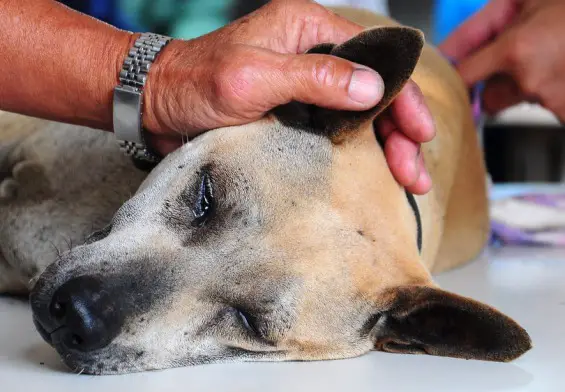Hemangiosarcoma Dog Life Expectancy – is the Spleen Tumor Painful?
Hemangiosarcoma is a type of cancer that doesn’t give an early sign on most occasions. Most of the accompanying symptoms are usually nonspecific, and the diagnosis is often made only after serious events like hemorrhage and rupture of the tumor. Because of this, you may not even know your dog is ill until it is diagnosed. It means the owners are not always allowed to decide to euthanize, and they will not know when to put their dog to rest.
The sad part is that most owners will find themselves in a position where they must decide whether to euthanize the dog right there at the spot. Only very few lucky owners can get ample time to ponder on the thought before approving to euthanize their dog. Although I’m not a vet, I’ve had interactions with several people who had to decide to euthanize their adorable pet on the spot. As you read further into this article, i hope you’d find this work helpful in case you are at the same position as these many pet owners.
What is the Best Time to Euthanize a dog Having Hemangiosarcoma?
HSA in dogs often goes unnoticed until it is in a very advanced and aggressive stage. Also, it is very resistant to regular surgery and treatment methods, so the owners are often required to take the tough decision of leaving the dog with the vet after the diagnosis.
This does not always happen, and so, it depends on the hemangiosarcoma type and the prognosis. As an example, if it is hemangiosarcoma of the skin, the prognosis may be good. Treating is possible by surgery, which means a longer life expectancy for your dog, and euthanasia can be delayed.
Knowing when to decide whether to euthanize a dog with hemangiosarcoma is totally up to you, but it should be based on your vet recommendations. There is, however, a 60% risk of hypodermal hemangiosarcoma, located beneath the top layer of the skin, spreading inward. In such a case, the life expectancy of the dog will drop drastically, so putting it to beg will be inevitable.
A more severe hemangiosarcoma (visceral) affects the internal organs. It quickly spreads, leading to excessive bleeding and tumor hemorrhage. In a case, the veterinarian will advise that you put the dog to rest due to its fatality rate.
Is Euthanizing a Dog with Hemangiosarcoma Recommended?
You should consult your veterinarian to determine if it is best to euthanize your dog or not. There are several factors involved in determining if your dog with hemangiomas should be euthanized and include:
- Talk to your veterinarian about the prognosis: in some visceral hemangiosarcoma, surgery may help. The survival rate for hemangiosarcoma of the skin is even higher.
- Evaluate the quality of life of the Dog: Some hemangiosarcoma surgery on the skin can reduce the likelihood of the disease spreading internally. . However, in case you noticed rapid weight loss, loss of appetite, lack of impulse, lethargy, and pain, then euthanasia should be considered.
- Cost Consideration: Visceral hemangiosarcoma is not treatable, and while some surgeries may give temporary relief, your dog will eventually die as a result of HSA.
Do dogs go Through Much pain with Hemangiosarcoma?
Most dog owners decide to euthanize their dog with hemangiosarcoma because of the pain, but here’s the difficulty, because you probably won’t know your dog has the disease as it’s not always so obvious. A dog with dermal or visceral and cutaneous hemangiosarcoma may walk around a little without signs of pain. The first time most people become aware of this disease is when it has resulted in bleeding, and at this point, it may be too late. Although it was diagnosed with hemangiosarcoma, and there is no bleeding, the dog may not suffer much but only experience weakness and bleeding as the disease progresses.
Causes of Dog Hemangiosarcoma?
Scientists do not fully understand the exact causes of canine hemangiosarcoma. Interestingly, they have been able to find out some dog breeds that are more at risk of HSA than other species. This means the genetics of the dog may be at play. Some research shows that these tend to be very common in large dog breeds. Some include
Research suggests that it tends to be larger dog breeds where the disease is most common. The breeds said to be more at risk of developing HSA include:
- English Setters
- Whippets
- German Shepherds
- Dobermans
- Dalmatians
- Portuguese Water Dogs
- Boxers
- Skye Terries
- Golden Retrievers
- Basset Hounds
- Flat-Coated Retrievers
- Labrador Retrievers
- Poodles
- Great Danes
Is it Possible for Dogs to Survive Hemangiosarcoma?
The HSA survival rate for dogs is the key to determining when it is time to put your dog to rest or to exercise patience. Several dogs have survived it, and yours too can; however, you should consult a specialist for a better explanation and advice.
Here are some basic rules that could serve as a guide for you:
- Skin (Dermal) Hemangiosarcoma: HSA in the skin of dogs can be treated with surgical removal of the cancerous tissue, and in some cases, it is curable.
- Subcutaneous(HypoDermal) Hemangiosarcoma: This is more severe than the skin, and in about 60% of cases, it spreads internally. When it results in spreading internally, the chances of survival become lower.
- Visceral vascular (internal organs) carcinoma: If there is an internal fracture of the tumors, even with surgery, the prognosis is not good, and the chance of survival low.
How Long Does a Dog with Hemangiosarcoma Have to Live?
The amount of time a dog with Hemangiosarcoma has more to live depends on the disease type, as discussed earlier. Based on the information we got from the Whole Dog Journal website, once diagnosed, you can expect the following:
The average lifespan of dogs with Hemangiosarcoma is only six months. 6-13% of dogs treated with surgery will survive after 12 months. 12-20% of dogs treated with surgery, plus chemotherapy will survive after 12 months.
Unfortunately, nearly every dog with HSA will end up succumbing to the disease due to tumor rupture or organ metastasis. None of the stat is good to rear. So you may have to decide on euthanizing the dog of your vet recommends that you do.
How long does a Dog with Hemangiosarcoma Have to Live without Surgery?
As per the information I got from the Whole Dog Journal website regarding how long a dog suffering from hemangiosarcoma has to live without surgical help:
- Untreated dogs with Skin HSA have a wide variation in survival rate. Some can be very high and others low.
- Dogs suffering from Hypodermal HSA have about six months to live, of no surgical help is given.
- Dogs with viseral HSA die between 7-14 days without surgical help.
Options for Treatment
Before deciding to give your vet the go-ahead to euthanize your dog, you should discuss all possible treatment options with him, as it depends on the HSA type.
Visceral hemangiosarcoma often tends to go unnoticed until it has reached the final stage, where it will not be curbed by treatments like chemo, surgery, and radiation therapy. Unfortunately, your dog may die from this cancer or must be euthanized. As for Skin hemangiosarcoma, it can be treated if it hasn’t gotten to the stage of internal hemorrhage.
You may have also read of natural remedies and treatments for hemangiosarcoma for dogs. Although we can understand that owners are trying to find a solution to prevents their lovely pet’s dog from dying from the disease, please do not allow anyone to fool you.
There is some good information on the website of the Canine Health Foundation, which is supported and funded by the American Kennel Club. It noted that these several so-called alternative approaches that are becoming popular are only doing that because people are eager to get a cure for their canine hemangiosarcoma. Their publicity usually follows after a dog has been treated and has survived longer than expected, leading them to attribute the pet’s recovery as proof of the effectiveness of their curative method.
There is no evidence that one of those treatments has been consistently successful.
Conclusion
Determining when to euthanize a dog is a very difficult exercise and a nightmare to any pet owner. Generally, when it comes to several other diseases, you will have time to think and make an informed decision before opting for Euthanasia.
However, HSA is a type of canine cancer that can be affects dogs quickly and destroys their health fast. For this reason, most people will find themselves in a situation where they have to consent to this act quickly and without much time to consider any other options.
The more fatal ones affecting the internal organs and the less fatal ones that only affects the surface of the skin can all lead to serious pain and death of the pet if no urgent help is provided. Since this disease’s diagnosis is often not good news, a professional consultation with a veterinarian with some pragmatism on your part as the pet owner is your best option.





